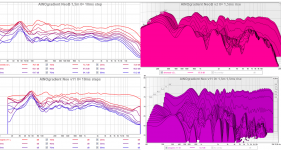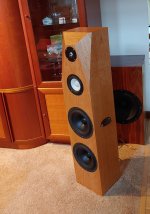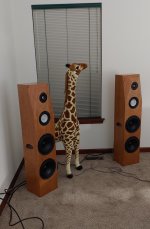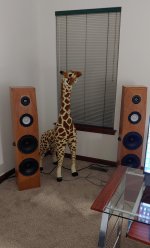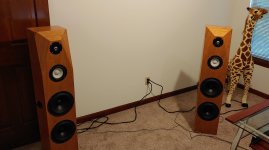The splashiness might have something to do with wider dispersion of the bare tweeter in the top 2 octaves.
The reason I say this is I feel the same auditory effect when switching between the XT25 vs DX25, level matched via DSP in the same design with a high quality midrange. Although both the XT25 and DX25 are bare, (without waveguides), the XT25 sounds more focused, and more relaxed. I definitely prefer the XT25.
@5th element went on to a waveguided tweeter, the SEAS DXT, and then further with his own coaxial design and I think with each step the "improvement" continued, if my interpretation is correct.
Meanwhile Dennis Murphy prefers bare tweeters. And he uses ribbons with ultra-wide horizontal dispersion.
I think the room must make a big difference. If we take our speaker outside one fine day, do we still prefer one over the other?
Too many experiments so little time...
The reason I say this is I feel the same auditory effect when switching between the XT25 vs DX25, level matched via DSP in the same design with a high quality midrange. Although both the XT25 and DX25 are bare, (without waveguides), the XT25 sounds more focused, and more relaxed. I definitely prefer the XT25.
@5th element went on to a waveguided tweeter, the SEAS DXT, and then further with his own coaxial design and I think with each step the "improvement" continued, if my interpretation is correct.
Meanwhile Dennis Murphy prefers bare tweeters. And he uses ribbons with ultra-wide horizontal dispersion.
I think the room must make a big difference. If we take our speaker outside one fine day, do we still prefer one over the other?
Too many experiments so little time...
Assuming that oneself would come to the same conclusion about non-waveguided tweeters sounding "splashy", the next question would be: Is this splashiness something that could be "solved" by reducing the tweeter level (or maybe just the level in a certain region..)? Even if then the loudness might differ a little from the waveguided reference?
(Ignoring the very valid question whether any perceived splashiness might actually be a property of the recording rather than that of the playback system ... Something to keep in mind; but for the sake of the current discussion it can be ignored, obviously.)
(Ignoring the very valid question whether any perceived splashiness might actually be a property of the recording rather than that of the playback system ... Something to keep in mind; but for the sake of the current discussion it can be ignored, obviously.)
Is the splashyness (a perceived phenomenon) caused by wide radiation or by an uneven radiation being reflected back to the listener? I think the cause needs to be determined first.
Assuming that oneself would come to the same conclusion about non-waveguided tweeters sounding "splashy", the next question would be: Is this splashiness something that could be "solved" by reducing the tweeter level (or maybe just the level in a certain region..)? Even if then the loudness might differ a little from the waveguided reference?
(Ignoring the very valid question whether any perceived splashiness might actually be a property of the recording rather than that of the playback system ... Something to keep in mind; but for the sake of the current discussion it can be ignored, obviously.)
That’s a good point and a valid one.
It’s true that even when the on-axis frequency response is perfectly matched via DSP (to +/- 0.1dB) the off axis responses and thus listening window, power response, predicted in tool response or any other metric to which one can define a group of responses won’t be the same.
So what happens when you instead reduce the tweeter level? It’s sounds “less stringent” or “less prominent ” to “e to “lacking” to “dull” to “are my ears blocked with water” depending hmm hhyxhte on how much you’ve attenuated (or not booked upthe tweeter
Exactly my experience and impression as well.Sounds fun, I'll be awaiting your observations! Some years ago I did an experiment where I designed a small 2-way using the Vifa NE19VTT tweeter. One speaker had a waveguide and the other didn't. Everything else identical so I could switch back and forth between the two. My first session I had to bring the waveguide up in level one dB or so to get the speakers to sound similarly "loud". What was really interesting as I spent the next 2 hours comparing was how my initial perception changed. At first the bare tweeter sounded more spacious and the waveguide smaller or muted. But as I kept switching back and forth I found the waveguide had a calmness and focus about it that was appealing. More switching back and forth and the waveguide no longer sounded smaller, but correct, and the bare tweeter had become very "splashy". I did more sessions, and always tried to "reset" my brain so any preferences I'd developed could be reset (not easy, but at least I made the attempt). I never could go back to liking the bare tweeter, it always sounded splashy and just had too much energy thrown around. Now I hear when I listen to many other hifi designs. That sold me on the waveguide, but it still very enlightening that my initial impressions in that first hour of listening were so different than what I expected going into the test, and changed so much as I listened.
You guys are talking about tweeter waveguides like they were all same. Eg. SEAS DXT I wouldn't call wg at all, it has so weak and narrow effect. Data is sparse and distributed around www, so comparisons aren't easy. I checked my measurements, but didn't find in-room measurements from same location for DXT, waveguide and flat baffle.
Another thing that I'm not sure about is that our hearing and room acoustics work differently for say 2kHz and 10kHz - and in-between. I believe that above say 6kHz direct sound dominates, reflections are attenuated remarkably and also "relative" delay (per cycles) makes transients diffuse.
Another thing that I'm not sure about is that our hearing and room acoustics work differently for say 2kHz and 10kHz - and in-between. I believe that above say 6kHz direct sound dominates, reflections are attenuated remarkably and also "relative" delay (per cycles) makes transients diffuse.
Yes, I should clarify I'm taking about relatively shallow waveguides like mine, or Pida's, or even the DXT.You guys are talking about tweeter waveguides like they were all same.
Difference in radiation pattern can easily be seen in decay of a room measurement.
My AINOgradients evolution has three different stages - first was Fountek ribbon with deep waveguide, then added with backside dome, finally planar with open back. Speakers are dipole from 150Hz up, until tweeter looses dipole pattern and behaves like two opposed monopoles with increasing directivity. All these do sound very different, I set them up to have similar response 0-30deg frontal on-axis (quasi-anechoic). The diffrencies happened wider than 30deg and on the backside. Decay shows bigger difference than listening spot response.
Here Fountek with and without backside dome. Dome was pointed 45deg up.
My AINOgradients evolution has three different stages - first was Fountek ribbon with deep waveguide, then added with backside dome, finally planar with open back. Speakers are dipole from 150Hz up, until tweeter looses dipole pattern and behaves like two opposed monopoles with increasing directivity. All these do sound very different, I set them up to have similar response 0-30deg frontal on-axis (quasi-anechoic). The diffrencies happened wider than 30deg and on the backside. Decay shows bigger difference than listening spot response.
Here Fountek with and without backside dome. Dome was pointed 45deg up.
Attachments
You are right Juha,
All waveguides are different, all coaxials are different.
So what happens in different rooms? Is your preferred one preferable in all rooms?
All waveguides are different, all coaxials are different.
So what happens in different rooms? Is your preferred one preferable in all rooms?
^No. And no for stereo and HT. In my opinion, dipole or wide dispersion monopole are best for stereo in big rooms. Coaxial or other narrow dispersion monopoles (or even cardioids like D&D or synergy horns) are best for HT, nearfield and small and damped rooms. I have never heard hifi line arrays, so I can't give a recommendation about them. Any type of speakers can have smooth and wide spl response and low distortion, so that aspect is not an issue.
They all give different imaging and spaciousness, and finally personal preference will vary! Everyone should give a chance for each type of speakers - visit audio shows and hifi-friends, listen and discuss!
They all give different imaging and spaciousness, and finally personal preference will vary! Everyone should give a chance for each type of speakers - visit audio shows and hifi-friends, listen and discuss!
Wonderful insight Juha,
Thank you. As I have previously stated, room acoustics make a big difference. I dare say 50%; as much (or more) as speakers and far more than DACs or amps or certainly tweakazoid cable lifters. Of course this is not palatable for a reviewer or salesperson to say- it's much easier to upgrade a DAC or amp or tweakazoid cable than to upgrade your room. Or build a new home based with plans dedicated around your listening area. @Zvu
Due to life circumstances, I have moved several times in recent years. Soon I'll be running out of fingers to count-
NINE times in thirteen years. So I've experienced a little about living room acoustics. Some fellows over at ASR think that all one needs to look at is a spinorama/CTA2034A measurement or preference score to make a purchase decision. But that is far from the reality. Just pickup your favorite speakers take it into a spare bedroom, kitchen or laundry room, and you will see. Of course most people don't take up this challenge it's implicit that they will sound difference (and because it's pain actually do- you need lug all your ancillary equipment like amplifiers and source equipment) but different living rooms sound different.
I mean, sure, one person can listen to music from your phone placed on the kitchen countertop, and yet still play the piano far better than I can (like my spouse). But the speaker that was previously "my favourite" in one room/house is no longer in another.
One of the reasons I've built so many speakers is that different rooms need different speakers.
One of the downsides of the loss of brick and mortar stores is the inability to discuss with an experienced retailer your requirements. They do exist- as fanatical or more about hi-fi than you the customer, seemingly without any interest in selling you anything. Online shopping and online reviewers are great, but sometimes we must go and seek out and audition and experience it.
Thank you. As I have previously stated, room acoustics make a big difference. I dare say 50%; as much (or more) as speakers and far more than DACs or amps or certainly tweakazoid cable lifters. Of course this is not palatable for a reviewer or salesperson to say- it's much easier to upgrade a DAC or amp or tweakazoid cable than to upgrade your room. Or build a new home based with plans dedicated around your listening area. @Zvu
Due to life circumstances, I have moved several times in recent years. Soon I'll be running out of fingers to count-
NINE times in thirteen years. So I've experienced a little about living room acoustics. Some fellows over at ASR think that all one needs to look at is a spinorama/CTA2034A measurement or preference score to make a purchase decision. But that is far from the reality. Just pickup your favorite speakers take it into a spare bedroom, kitchen or laundry room, and you will see. Of course most people don't take up this challenge it's implicit that they will sound difference (and because it's pain actually do- you need lug all your ancillary equipment like amplifiers and source equipment) but different living rooms sound different.
I mean, sure, one person can listen to music from your phone placed on the kitchen countertop, and yet still play the piano far better than I can (like my spouse). But the speaker that was previously "my favourite" in one room/house is no longer in another.
One of the reasons I've built so many speakers is that different rooms need different speakers.
One of the downsides of the loss of brick and mortar stores is the inability to discuss with an experienced retailer your requirements. They do exist- as fanatical or more about hi-fi than you the customer, seemingly without any interest in selling you anything. Online shopping and online reviewers are great, but sometimes we must go and seek out and audition and experience it.
Last edited:
In my previous post I forgot the effect of room RT (reflectiveness) A big living room with bare stone walls and high ceiling is quite popular, but has annoying echo (lots of late and loud reflections) In those narrow dispersion monopoles or cardioids or synergys or WMTMW towers might be preferred.
I have three pretty good diy sets in different rooms in my house - dipole pair for music with small 2-ways to make it HT 5.0 in the living room, coaxial 2-ways 5.1 system in a small and damped HT room and WWMT tower pair in our bedroom. Rooms are different, placement is different and yes, they sound different! All have pretty smooth Harman-type dsp-eq'd response 30-20000Hz and low distortion.
I have three pretty good diy sets in different rooms in my house - dipole pair for music with small 2-ways to make it HT 5.0 in the living room, coaxial 2-ways 5.1 system in a small and damped HT room and WWMT tower pair in our bedroom. Rooms are different, placement is different and yes, they sound different! All have pretty smooth Harman-type dsp-eq'd response 30-20000Hz and low distortion.
I think I have a better image that shows what I see in sims.That is diffraction
Probably need to rethink that one as well, the frequency response dips there in the measurements and for the main one at 1.6KHz that is due to the crossover. Time and frequency are linked you cannot look at one without seeing the other, you can trade resolution of one to the other and some things are easier to see in one domain or the other because of this. The waterfall dips line up with the FR dips marked in yellow, green is a dome waveguide interaction that disappears off axis. A waveguide can be made to be very flat on axis and linear off axis, but mostly there is some on axis wiggle left which disappears off axis. Without having simulated the waveguide with an ideal source, it is hard to know what comes from the waveguide or from the driver itself. A dome tweeter on it's own depending on the baffle will tend to do the opposite, flat on axis and wiggly off axis due to diffraction.
View attachment 1094793
Notice how if you go off-axis the peaks/dips are all in the same places but they can be seen on-axis. I see over a dozen lines. The sound power of anything that is trying to bend a round shape will kick back all kinds of mess. A horn/waveguide is a controlled mess and cannot be flat on and off-axis.
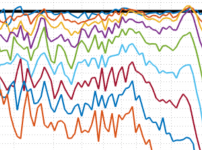
It is kinda like:

on-axis, no teeth. As you go off-axis, the same teeth get longer and longer.
I only own 1 pair of horns (jbl 580). When I measure the same sounds on all speaker the horns over-emphasize whatever it wants.
I do love the image from horns.
Am I seeing it wrong?
Photos of the finished project in the listening room. I realized I had not posted final pictures.
Agree. In a different room, the tower twin-8s could sound better than the TX system.
j.
Agree.In my opinion, dipole or wide dispersion monopole are best for stereo in big rooms. Coaxial or other narrow dispersion monopoles (or even cardioids like D&D or synergy horns) are best for HT, nearfield and small and damped rooms. I have never heard hifi line arrays, so I can't give a recommendation about them. Any type of speakers can have smooth and wide spl response and low distortion, so that aspect is not an issue.
They all give different imaging and spaciousness, and finally personal preference will vary! Everyone should give a chance for each type of speakers - visit audio shows and hifi-friends, listen and discuss!
One of the reasons I've built so many speakers is that different rooms need different speakers.
Agree. In a different room, the tower twin-8s could sound better than the TX system.
A waveguide design is on the future project list.I never could go back to liking the bare tweeter, it always sounded splashy and just had too much energy thrown around. Now I hear when I listen to many other hifi designs. That sold me on the waveguide, but it still very enlightening that my initial impressions in that first hour of listening were so different than what I expected going into the test, and changed so much as I listened.
j.
Attachments
There is a paper on changes to the shape of the ear and how long it takes for the mind to adapt to change. What is interesting, is the very first day of any ear change, people have perceptions that are beyond any later perceptions. It is like the brain does not know reality and it guesses wildly. After about a week, most people adapt to the change in ear shape and correctly perceive sounds.That sold me on the waveguide, but it still very enlightening that my initial impressions in that first hour of listening were so different than what I expected going into the test, and changed so much as I listened.
https://pubmed.ncbi.nlm.nih.gov/15930391/

The diff. colors are showing changes to the volume. When sounds are louder, we have less confusion. But still, day one is not as good as day seven.
It is not 1:1 to a changing out a speaker, but I always think of this paper when listening and comparing. Perception is not instantly correct. The brain takes time to have correct plasticity.
I can't argue against what you heard but there is an explanation for how perception can change over time.
There is a huge variety of horns and waveguides designed to do very different things so you cannot generalize. It is quite possible to make a waveguide that is very smooth on and off axis if the directivity is allowed to rise. When the directivity is held constant then the on axis and near axis has to give. The termination of the horn/guide is very important to ensure there are as few reflections as possible returning to the throat and the curvature itself determines how much internal diffraction there is. It does not have to be a mess.Notice how if you go off-axis the peaks/dips are all in the same places but they can be seen on-axis. I see over a dozen lines. The sound power of anything that is trying to bend a round shape will kick back all kinds of mess. A horn/waveguide is a controlled mess and cannot be flat on and off-axis.
It is hard to take measurements free of reflections, diffractive ripples that appear much the same in various off axis curves are often a fixed object in relation to the microphone reflecting and not the speaker itself. Sharp edges, abrupt changes in curvature and other things cause similar ripple but it almost always changes with position and is averaged out somewhat in a listening window response.
The JBL 530 measurements show some tonal problems which probably extend to the 580 but it doesn't look to be the fault of the horn.I only own 1 pair of horns (jbl 580). When I measure the same sounds on all speaker the horns over-emphasize whatever it wants.
I have been moving these speakers around to different rooms and positions. One thing I have noticed is that they are very tolerant of room size/shape and positioning. My office is 10.5' x 12' x 8' high... not great dimensions. The walls are completely bare, there is minimal furnishings, and the only absorption in the room is the carpet. Yet these speakers sound pretty good in here. Tonally they sound right. I found two positions in which the sound quality was quite nice and the imaging was very good. Given the size of the room it is almost a near-field situation.
To get the best spatial and imaging performance out of these, there needs to be more space around the speaker than I need with the TX system. But even with sub-optimal placement, they always sound reasonably good.
Of course this is the promise of a smooth DI which is either flat or slowly increasing. But it is nice to experience it.
I now wish that I had allowed Headshake to listen to them in their optimum position. I think their imaging/spatial illusion is as good as the TX system with the right placement. In terms of dynamics, clarity, bass performance, detail, and a sense of naturalness, the TX system still has an edge. But the towers are very very listenable. No regrets.
j.
To get the best spatial and imaging performance out of these, there needs to be more space around the speaker than I need with the TX system. But even with sub-optimal placement, they always sound reasonably good.
Of course this is the promise of a smooth DI which is either flat or slowly increasing. But it is nice to experience it.
I now wish that I had allowed Headshake to listen to them in their optimum position. I think their imaging/spatial illusion is as good as the TX system with the right placement. In terms of dynamics, clarity, bass performance, detail, and a sense of naturalness, the TX system still has an edge. But the towers are very very listenable. No regrets.
j.
Attachments
I made some interesting observations about horizontal and vertical polar measurements of this speaker in the VituixCad thread.
https://www.diyaudio.com/community/threads/vituixcad.307910/page-213#post-7251651
https://www.diyaudio.com/community/threads/vituixcad.307910/page-213#post-7251651
How is the JAB5 performing? I read on the forum (https://www.diyaudio.com/community/threads/wondom-jab-problems.395459/) that a user did face a problem with this board that was randomly stopping working after a while of using it.
I never got further than hooking the JAB5 board up to a power supply and confirming it had an input and output voltage. I mentioned this in post #98, but this is a long meandering thread, so it is hard to keep track of what is going on 😳
I may use the JAB5 in a future project, or maybe not.
I may use the JAB5 in a future project, or maybe not.
- Home
- Loudspeakers
- Multi-Way
- New Project - tower 3-way with twin 8s
